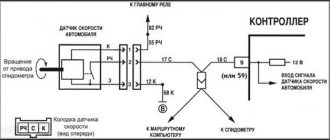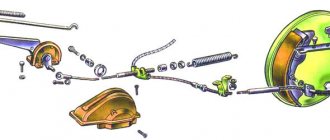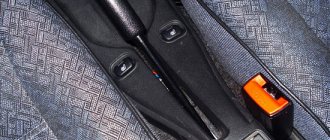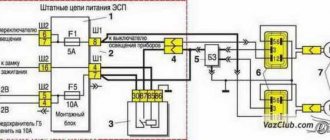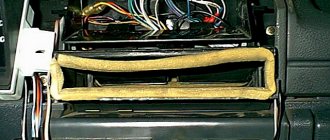Introduction
Over time, any mechanism begins to wear out greatly; quite often, car owners are faced with wear on the linings that are installed in the rear brake pads.
No less often, problems arise with pulling out the drive cables, which is why the vehicle owner has to periodically adjust the handbrake stroke. The material below provides step-by-step instructions, strictly following which every car enthusiast will be able to independently tighten the parking brake lever on a VAZ-2110 car, without resorting to the help of experienced specialists and, accordingly, saving a significant amount of money. It is worth noting that adjusting the handbrake using the method described below allows you to perform an identical manipulation on almost all front-wheel drive cars that have domestic roots. Many VAZ-2110 owners would like to know how to tighten or loosen the handbrake
The VAZ-2110 is a very common vehicle (if we consider it within Russia); experienced car enthusiasts and mechanics note the ease of pulling the handbrake in this car, as well as the ease of replacing it. Even novice drivers know how important it is to monitor the serviceability of this element of the vehicle. A malfunctioning part can cause the car to move independently. There is no need to even talk about the possible consequences, since they can be different.
The parking brake lever should be tightened immediately after detecting defects in its operation. The car owner must periodically check the system himself in order to be able to prevent troubles in time.
IZH 2126 Oda, Fabula | Topic author: Sky
BRAKES (including handbrake)
Kulichenko (Prabhavana) photo of installing rear disc brakes on IZH 2126-062 (4x4)
Leonid (Aramati) Moved from another topic Victor Tatachnarod, please tell me, has anyone installed a brake vacuum from 2110 on the ode? 28 Feb Alexander Korotkov 15:18 For this you need a GTZ VAZ 2109 or 2110 and an adapter plate, I can download the drawing of the plate or find it on the Internet, I myself will install it closer to Letumaksim Antonov 20:13 I also dream about this, the mention that you need to turn off one thing on the GTZ 2110 is confusing hole, until I realized what it was and that the flaring on our brake pipes for the GTZ is a little smaller than on the VAZ (may be snotty) Sky () 22:17 Subscribed to this topic, I’m also interested in this question. Victor Tatach23:09 no need, I already bought it from a Muscovite, there will be fewer problems! But the seller said that tens of them will last longer! 29 Feb Boris Sludnev16:00What's better than ten? Sky ()17:12Quality. Boris Sludnev18:05 Is that all? Alexander Korotkov19:33 from 10 or 9 only 3 advantages are availability, low price and braking will be better grasped not at the end, but at the beginning
Dmitry () Guys, can anyone tell me if we have our own rear brake pads or VAZ ones?
Sky () Front eight/nine, rear M-412 with slight modification
Dmitry () This is a hybrid, but why is it that the M-412 has 5-studded wheels, so we get our own drums and not from the 9 and Muscovite?
Sky () Yes, we have our own drums. I have no analogues.
Sky () Today I studied this problem from my own experience. I was driving calmly (I wasn’t bothering anyone), when I started to slow down at a turn, I heard a pop and some shuffling somewhere behind me. I stopped and looked - everything seemed fine. I drove on and the noise stopped. But at the first braking, there were strange sounds and a beating on the brake pedal, and the beating was quite noticeable. Fortunately, it was less than a kilometer away from the garage. I held out. The autopsy showed that the pads on the pads had fallen off on the left rear wheel, both of which were immediately visible. How so? - HZ. Moreover, in terms of thickness, the pads can still go on and on. oh well. There was a set of pads from M-412. Only it’s not a factory one, but a homemade one with rivets. I compared it externally - in terms of hardware - one to one with mine. Only the pad is quite thick. They fell into place normally, but in order to put the drum on, in addition to all the standard actions and measures, we had to sharpen the stops on the blocks. I called stops those places (protrusions) where the block from below and from above rests on the housing and on the hydraulic cylinder. And the drum was somehow put on. Apparently all this happened because the linings on these homemade pads are too thick. When driving, it turned out that the pads rub against the drum and it heats up quite well. Who knows how bad it is, well, in the sense of such friction and heating. Maybe it's worth changing the pads to store-bought ones with thinner pads?
Dmitry () SKY CHANGED FOR NEW OR RIVETED ON RIVETED
Leonid (Aramati) I also changed it, sharpened it, and it’s still driving, everything has gotten used to it and doesn’t heat up.
Leonid (Aramati) I suspect that my brake vacuum is failing. When you press the brake pedal, it hisses, but the engine is still running stable and the brakes are present.
Sky () It may simply be that the vacuum valve is faulty or there is a leak in the hose. I also had a hiss there when the engine was running. When you press the brake, the hissing stops. Moreover, when you press the brake, the engine speed drops by about 250. Yesterday I tightened the clamp, twisted the valve in the seal and the hissing stopped. The rpms began to drop by about 100.
Leonid (Aramati) The hissing is heard only in the cabin and the pedal falls slightly, then it rests and there are brakes. The engine speed does not drop
Sky () And I also heard hissing from the cabin. The pedal itself has a long and soft stroke. But the revs should drop a little.
Leonid (Aramati) Everything works smoothly, I got a used vacuum, how can I check it?
Leonid (Aramati) Maybe they should fall, but they don’t.
Leonid (Aramati) I don’t feel like changing now, maybe I’ll travel some more?
Sky () When my carb started acting up last year, I went to a professional for an adjustment. Although before that I twisted and cleaned it myself. When everything was done, they started checking in front of me. I'm driving, they're under the hood - Press the brake pedal. - Pressed. (The revs dropped a little) I told them about this - the Master said that this is how it should be and this is correct.
Sky () Yes, in principle it can and is possible, as long as the brakes work.
The handbrake of the VAZ 2110 does not hold - Cheboksary
The handbrake does not hold at ten. In auto repair shops, something is recorded almost a few days in advance. I would like to change today from .
What should you do if the handbrake doesn't hold? - Let's all go!
This problem often occurs when the handbrake does not hold. . When the handbrake doesn't hold, you can tighten it to 13 using a sawn-in-two wrench. . brake pads VAZ-2110 Replacing front brake pads with .
Parking brake VAZ 2110
The principle of operation of such an element of the VAZ 2110 car as the hand (also known as parking) brake is quite simple. A special cable is used as a mechanical drive for the device. By pulling the handbrake handle, the driver simultaneously provides tension on the cable, which occurs evenly on the brake pads of each wheel. If the parking brake is faulty, you should carry out work such as VAZ 2110 adjusting the handbrake, or repair it by replacing the cable. It is noteworthy that it is easy and simple on the VAZ 2110 to both tighten the handbrake and replace it. If the handbrake malfunctions, the driver runs the risk that the car will move on its own or, conversely, will not be able to continue driving after stopping on an uphill slope. That is why you will have to adjust the handbrake in any case - and this can be done without necessarily going to a car service center. An experienced car enthusiast is able to adjust the parking handbrake of a domestic car on his own.
Aspects indicating the need to adjust the handbrake
There are several ways that will help any car owner, without exception, to help with the question of whether it is advisable to adjust the handbrake. It is worth noting that there is no need to check the handbrake every day; it is important to pay attention to this detail every 30 thousand kilometers.
To find out whether the handbrake needs to be adjusted, you need to park your car on a slight slope, then leave the car on the handbrake and put the gear in neutral. If the vehicle slowly but surely begins to move down an incline, then the vehicle's parking brake may not be working properly.
Of course, this problem can be solved by replacing the VAZ-2110 handbrake rod, however, as practice shows, it is quite enough to make a very simple adjustment of this part.
What does a handbrake consist of?
To successfully carry out any repair work, you need to know what the element that requires it consists of. The handbrake device is not complicated, but still, you need to pay attention to it.
The visible elements of the handbrake drive include the locking button and the lever itself. The remaining parts are hidden, including: a protective cover, a handbrake rod, a cable equalizer, an adjustment nut, a control nut and a sheathed cable.
There is a mechanism on the rear wheel that is responsible for braking directly. This is where the pads are located, which need to be changed regularly, the drum, the condition of which also needs to be monitored, and other parts that make up the wheel locking mechanism.
Step-by-step instructions that allow you to independently tighten the handbrake on a VAZ-2110 car
If the car owner does not know how to tighten the handbrake on a VAZ-2110, he should familiarize himself with the recommendations below, and, first of all, it will be necessary to drive onto a viewing hole, lift or overpass, in other words, you need to position the car so that the owner can easily get to the necessary mechanisms and components.
List of actions by which the VAZ-2110 handbrake will be adjusted:
- the car is positioned in a way that is convenient for the owner (placed on an overpass, raised with a jack or driven into a ditch);
- the handbrake lever is placed in the lowest position;
- the lock nut is loosened using one wrench, when a second standard tool tightens the adjusting nut at the same time (it should be tightened until the car owner is confident that the handbrake cable is properly tightened). As practice shows, pliers can help the vehicle owner cope with the task, which are convenient for supporting the rod while tightening the adjusting nut;
- those adjusting the lever must check its full stroke, which should be about 2–4 clicks;
- then the equalizer locknut is tightened (do not forget that the second adjusting nut must be supported at all times by a second tool);
- the handbrake goes down, and the rear wheels, using the power of human hands, turn in the desired direction. If everything is done correctly, the wheels will “walk” without jamming.
The adjustment of the handbrake is considered a very simple and quick procedure; the only thing you should pay due attention to is the handbrake drive cable. If during the process it was not possible to tighten it properly, this element should be completely replaced in the near future.
After the adjustment of the VAZ-2110 handbrake is completed, it is necessary to again check the quality of the functioning system. It is preferable to park the car on a section of the road where there is a slope of at least 25%, then put the car on the handbrake in the “neutral” position. With reliable fixation (correctly adjusted lever), the car will remain in place, which will be direct evidence of a job well done by the car owner.
Design
Many people mistakenly believe that the handbrake is a simple lever located near the gearbox, on the right hand of the driver. In fact, it is a whole system of elements that are connected to each other.
When the hand brake fails, in 90% of cases the culprit is a cable or a pair of cables that go to the rear brake pads from the equalizer.
To determine the reasons for the failure of the handbrake, it is necessary to understand the circuit diagram of the device and its components.
Handbrake diagram
The device includes a number of structural elements. Namely:
- Lever arm;
- Traction;
- Springs;
- Lever button;
- Main cable axis;
- Bolts;
- Washers;
- Drive unit;
- Equalizer;
- Case;
- Locknuts;
- Cotter pins;
- Right and left lever;
- Expansion left and right strip;
- Lock washer, etc.
What to do next if adjustment does not help?
There are situations when a car owner knows how to tighten the handbrake on a VAZ-2110 and strictly follows the algorithm, however, the manipulations he has carried out do not change the situation and the handbrake also works poorly. Most often, this problem occurs when the parking brake lever cable breaks. As practice shows, owners of old VAZ-2110 cars find themselves in this situation more often than others. You should not assume that under intense load the cable will function for too long even on newer domestic models.
The cable in a VAZ-2110 car should be changed if the tips are significantly weakened, its threads are strongly stretched and this part is difficult to move in its shell. It is worth noting that the car owner can do the work of replacing the cable on his own; you just need to have an assistant and some free time. It is very difficult to replace the cable alone.
Repair methods
A quick but costly way to get rid of handbrake problems is, of course, to go to a service station. The cost of such a service is about 400 rubles. However, is it worth spending money on something that you can do yourself, especially without much effort? Applying the parking brake yourself is not that difficult, and the savings are not small.
If you practice enough, tensioning the cable or replacing the pads will take no more than half an hour. Experienced car enthusiasts can handle this faster. Some operations require welding, so having the appropriate equipment and skills will not hurt. But this usually only applies to those who do not want to replace old parts with new ones, and prefer to repair worn-out elements with their own hands.
VAZ 2110 why the handbrake does not work
Dear visitors of the “Cars” website! We will be very grateful for your comments on the video clip “VAZ 2110 why the handbrake does not work”; registration is not required for this. We also ask you to let us know if you have any problems playing the video.
The parking brake is not intended for emergency braking, which is clear even from its name - PARKING
09.18.2017 — 10:51 wolkodaw wot
I bought myself a 2115, it was the same thing, I changed the fittings, the spacer bars, the hooks, etc. I didn’t change the pads, it became normal, you can’t move it on the handbrake, but it doesn’t jam while driving anyway, I think I can put the whole system back from 2141, the spacers are adjustable and it jams while driving anyway at least there's nothing left of the pads
02.09.2017 — 08:22 Ruslan
anti advertising according to European standard
08.23.2017 — 12:11 Ilkin Rakhmanov
When replacing the rear pads to bleed air on the rear cylinders, one presses the brake and holds it and the other bleeds air until fluid appears
08/12/2017 — 16:25 Georgy Bulanov
you need to drive for everything to get used to it, it won’t brake right away as it should
07/21/2017 — 06:59 Andrey Demidov
On the cable itself on the spring, carefully bite off a couple of turns and everything will hold and slow down
07/11/2017 — 02:21 Andrey Demidov
Yes, and I see the drums are from viburnum; they are larger in diameter; install original drums
Causes of handbrake malfunction
Breaking the handbrake is not such a rare occurrence and cable stretching is not the only problem. It happens that even after tightening the handbrake of the VAZ 2114 does not hold. We will take a closer look at the most common causes of this phenomenon.
The parking brake has a simple design, however, there is something to break in it.
There may be several reasons for this:
- Worn brake pads;
- Rope rupture or deformation;
- Drum wear.
Any elements of the handbrake system may also be worn out or subject to mechanical damage. In such cases, the problem is detected by eye or at service stations.
The handbrake does not work even if the cable falls off the lever. Any high-quality sealant that can prevent slipping will help here, or you can simply tighten the handbrake cable.
VAZ 2110 why the handbrake does not work
Dear visitors of the site “Everything about cars”! We will be very grateful for your comments on the video clip “VAZ 2110 why the handbrake does not work”; registration is not required for this. We also ask you to let us know if you have any problems playing the video.
The parking brake is not intended for emergency braking, which is clear even from its name - PARKING
08/22/2017 — 23:04 wolkodaw wot
I bought myself a 2115, it was the same thing, I changed the fittings, the spacer bars, the hooks, etc. I didn’t change the pads, it became normal, you can’t move it on the handbrake, but it doesn’t jam while driving anyway, I think I can put the whole system back from 2141, the spacers are adjustable and it jams while driving anyway at least there's nothing left of the pads
07/30/2017 — 21:24 Ruslan
anti advertising according to European standard
07/10/2017 — 08:55 Ilkin Rakhmanov
When replacing the rear pads to bleed air on the rear cylinders, one presses the brake and holds it and the other bleeds air until fluid appears
04.07.2017 — 17:37 Georgy Bulanov
you need to drive for everything to get used to it, it won’t brake right away as it should
06/13/2017 — 13:12 Andrey Demidov
On the cable itself on the spring, carefully bite off a couple of turns and everything will hold and slow down
05/30/2017 — 23:24 Andrey Demidov
Yes, and I see the drums are from viburnum; they are larger in diameter; install original drums
05/21/2017 — 10:29 Alexander Bystrykh
how many clicks does the handbrake take?
05/07/2017 — 23:03 Alexander Bystrykh
I just heard so much and I pull 3-4 silks myself, but you can hear a lot, this also plays a role
04/23/2017 — 00:30 Alexander Bystrykh
I tighten it 3-4 clicks
04/21/2017 — 09:03 Alexander Bystrykh
and if it changes quickly, it means the cable is stretching
04/10/2017 — 22:56 Max
I've been driving a VAZ for many years. and when replacing the cables I noticed this thing. when you lift the handbrake. the cable goes into the braided tube, the plate moves the pads apart, and the spring on the cable is compressed. Well, often this very spring is compressed to its very best. There is nowhere to compress it further... and the plate has not yet fully spread the pads. I just cut off a quarter of the length of the spring with a grinder. so that the cable travel increases.. the main thing is not to rip the cable. and also hang the cables before installation and pour oil into the synthetic braid with a syringe. not much. let it drain. You can use the cable while you pour. it will slide normally and the beard will appear much later. In short, he will live many times longer. verified
I don’t know how 14 but on the classic there is also a cable for the handbrake stick itself, it also stretches if anything
03/15/2017 — 03:27 Sergey Nikonorov
VAZ 2112 how to improve brakes | Topic author: Cristina
I came across this problem. This is with the brakes for some reason, it seems to me that my brakes are not very good on the VAZ2112 because when braking sharply, the front right one grabbed me, then the left one, about the rear I’m generally silent there, it barely grabbed it. with all this, I have replaced it (vacuum + a distributor goes to it, then the front discs with pads are also new! moving to the rear, new cast iron drums + brake pads are also new) and what to do, what else can I change? I just would like better brakes. and one more problem I have on the VAZ 2112 is the air conditioner, everything is as it should be for comfort, only one thing bothers the food when the air conditioner is turned off and the engine temperature constantly rises, it doesn’t matter whether it’s winter or summer. replaced (new radiator, pipes, antifreeze, thermostat, pump, engine, washed the cooling system and pressed it under pressure) went to a computer technician, all the rules show that the screw turns on at 85 and turns off at 92! and the dashboard shows that everything is on the red line, and who can tell me what to do?
Yury (Stojanka) Kolya, VUT TRW (number PSA526) + GTZ TRW (number PMK482) + two adapters WPP-139, WPP-137.
Viktor (Correen) There’s a lot of text, so I’ll just answer the question! The vacuum unit is assembled with the Lucas TRV GTZ, 14-inch front brake discs (good if they are already installed), they have Tornao or Volgov brake calipers for 14-inch brake discs, or even 15-inch ones! Or you can just add 15-inch brakes from the Kalina Sport! Rear disc brakes with mechanical handbrake! That's all!
Yury (Stojanka) Victor, the only problem with the Kalina-Sport brakes is still the same dead caliper only through a spacer. Volgov wheels for 14, 15 are a normal option. Or serious companies AP Racing, etc.
Viktor (Correen) Yuri, you can use Volgov calipers, or Tornado calipers, I saw them on the sports tuning website for 5-6 kes, a set of 2 pieces! An excellent alternative to 4-piston calipers!
Andrey (Alethea) Victor, not great, but awesome
Yury (Stojanka) Victor, and EBC GreenStaff pads
Kolya (Zolin) Alexander, thank you!! I’m also guilty of tidying up, but who knows?
Evgeny (Keigo) What about Brembo? Is it worth buying them or is there something better and more modest?
Lekha (Demetria) guys, I installed the main one and the vacuum cleaner from the Priora, I’m not complaining, it’s become more fun!!
Is adjustment necessary?
First you need to determine whether the adjustment will really solve the problem of the handbrake malfunction.
Adjusting the parking brake
To do this, a small test is carried out. Moreover, it is recommended to do a similar procedure after every 30 thousand kilometers, even if you are sure that the parking brake works well.
Drawing conclusions
The serviceability of the brake system must be monitored first of all, because your safety and the safety of the car depend on it. Moreover, such a VAZ hand brake has a simple design, and repairs do not require complex tools. Domestic cars do not have complex elements or non-standard fasteners and are repaired with the usual garage equipment of the average motorist.
Take care of your car, and it will repay you with longevity and trouble-free operation.
Pulling up the handbrake
It is likely that you just need to tighten the parking brake on the VAZ 2110 to fix the problem.
- Drive to the inspection hole, from where it is most convenient to make adjustments. Another option is a lift. You'll find something here. This way you can easily get to the necessary nodes.
- Make sure the brake lever is in its lowest position.
- Take two keys. You will loosen the lock nut first and tighten the adjusting nut second.
- Tighten the adjustment nut until the cable is properly tensioned.
- It is strongly recommended to hold the rod when tightening the adjustment nut with pliers.
- Now make sure that the lever makes full travel in 2-4 clicks, no more.
- If after checking everything turned out to be good and the working stroke is correct, tighten the equalizer locknut while holding the adjustment nut with a second wrench.
- Release the handbrake lever down and turn the rear wheels by hand. Rotation should occur evenly without any jamming.
- But if the adjustment did not allow the cable to be tensioned, then the element must be replaced.
What is needed to adjust the handbrake
To adjust the parking brake, you will need one of the following tools:
In the absence of all these conditions, which any ordinary driver is unlikely to be able to provide, you can get by with support “goats”, which are installed under the rear of the body after it has been raised with a jack. It is also worth considering the presence of two “13” keys and pliers in the set.
Where to start adjusting
VAZ 2110 handbrake does not work
The parking brake adjustment process is as follows:
- the car is placed on an overpass (or a ditch, or generally raised with a jack);
- the position of the brake lever is checked - it should be the lowest;
- Using the first key, the lock nut is loosened, while at the same time holding the adjusting nut with the second key.
- The adjusting nut is tightened until the handbrake cable is tensioned.
Note. When tightening the adjusting nut, the rod must be held with pliers.
VAZ 2110 tighten the handbrake
- Now you should make sure that the full stroke of the lever is from 2 to 4 clicks;
- After the stroke has been checked, the equalizer locknut should be tightened while holding the adjusting nut with a wrench.
- The handbrake lever goes down, after which the rear wheels are turned by hand. Their rotation should occur evenly and without jamming.
Note. If the handbrake drive cable cannot be tensioned during the adjustment process, this part should be replaced.
VAZ 2110 handbrake adjustment
After the system has been adjusted, it is necessary to check the quality of its operation again. To do this, after all the work performed by the driver, you should find a section of the road with a slope of at least 23%, then stop the car on it and put it on the handbrake. If the brakes reliably hold the car on the rise, then everything was done correctly.
What to do if the adjustment did not help
VAZ 2110 handbrake does not hold
In some cases, adjustment is indeed not enough. This happens in cases where the handbrake cable breaks - a rather rare phenomenon, but still happens, especially on older cars. It happens that the cable breaks on newer models that are subjected to too intense use, which the brake system of an average car is not designed for.
VAZ 2110 manual brake adjustment
The cable should also be replaced in the following situations:
- when its tips are loose;
- the cable threads began to stretch (this could soon lead to a break);
- the cable moves quite hard in its sheath even after it has been lubricated.
Like adjusting the handbrake, an operation such as replacing the parking brake cable does not necessarily require a visit to a car service center. And, although it will most likely take much more time to complete, such repairs do not require special professional skills, equipment or any specialized tools.
Note. Still, some conditions must be met when replacing the cable. For this work, the driver will need an assistant who will strongly pull the cable in order to correctly install the equalizer.
If the adjustment does not help
There are not many cases when adjusting the parking brake did not have any effect. However, this is no reason to despair.
Device diagram
There are several situations in which it is necessary to replace the parking brake cable:
- The cable broke;
- The tips gave way;
- The cable threads have stretches, which over time can turn into a full-fledged rupture;
- The cable is difficult to move inside the sheath even after abundant lubrication.
Is it possible to restore without changing
If the cable has soured, but is not torn, but simply rusted, then it can be developed and partially restored. Of course, this is the wrong approach and can only serve as a temporary solution.
Try the following procedures:
- Sit behind the wheel, press the button on the handbrake handle and pull it up and down many times. If, apart from corrosion, there is no damage to the cable, then the functionality of the mechanism should be restored. You will have to pull for a long time for the rusty cables to start working.
- Another, more complex and time-consuming method is to remove the cables from the machine and lubricate them. Few people do this, but it also helps. The process of removing the handbrake cables from the car differs on different models. This will require an overpass or a hole in the garage. After removing the cables, you also need to pull them in different directions, and then try to lubricate them with engine oil. To do this, lubricant must be dripped inside the braid. It's a lot of work, but it often helps and extends the service life by several years.
Replacement
There is one important condition - you will need an assistant. His task will be to pull the cable tightly, which will allow the equalizer to be installed correctly.
The sequence of work to replace the cable is as follows:
- Lower the handbrake lever as far as possible;
- Remove the brake disc from the wheel where the element is being replaced;
- Remove the muffler from the suspension cushions and the resonator from the rear suspension;
- Lower the exhaust system down;
- Remove the adjusting nut and locknut;
- Remove the equalizer;
- Now remove the cable ends from the equalizer;
- Remove the tip of the equalizer shell from the bracket, which is located on the car body;
- Bend back the brackets that secure the cable;
- Remove the rear brake pad and remove the cable end from the lever;
- Slightly loosen the nut that secures the cable holder to the rear axle;
- Remove the cable from the holder, then from the bracket, and then pull it out through the brake spike;
- Place a new cable in its new location and perform the assembly procedure, following the reverse order of the indicated processes;
- Make sure that the cables in the bracket are positioned crosswise;
- After completing the installation of the new element, adjust the handbrake.
As you can see, the task does have certain nuances, but it is not difficult at all if you have some experience and rely on the VAZ 2110 operating manual. As a rule, everything is spelled out there.
It wouldn’t hurt to supplement your skills and knowledge with video tutorials or consultation with a friend from a service station. But if you are not confident in your own abilities, you should not risk replacing the handbrake cable yourself. It is better to spend more money, but entrust the work to specialists.
Parking brake screw-nut
Such parking brake mechanisms are used in a number of foreign cars. Below is the design and operating principle of the parking brake used on Volvo cars.
When the parking (hand) brake lever is lifted, the cable moves relative to the braid resting on the bracket 9 and, using the lever 8, turns the shaft 7 around the axis, at the other end of which there is a plate 6 with three conical sockets of variable depth. Each socket contains a ball 11. Together with the ring 10, these parts form a mechanism that, when rotated, causes the shaft 7 to move in the axial direction. The conical sockets are designed in such a way that the initially large axial movement relative to the rotational movement becomes small, thereby increasing the transmitted force. The axial movement of the shaft 7 is transmitted to the head of the screw 5, which, compressing the spring 12, through the nut 4 transmits force to the piston 3 mounted in the floating bracket 13, and together with the bracket, acting through the brake pads 2, clamps the brake disc 1.
The effect of self-regulation of the parking brake occurs due to the fact that as the “brake pads - brake disc” pair wears out, an increased gap appears and, without encountering resistance, shaft 7 turns screw 5 relative to nut 4, which leads to a decrease in the gap between the brake pads and the disc. The screw-nut pair (items 5 and 4) has play in the threaded connection, which allows the brake mechanism to release the brake disc when the parking brake is not applied.
Rice. Parking brake mechanism: 1 – brake disc; 2 – brake pads; 3 – piston; 4 – nut; 5 – screw; 6 – plate; 7 – shaft; 8 – lever; 9 – bracket; 10 – ring; 11 – ball; 12 spring; 13 – floating bracket
The parking brake is usually driven through a cable by pulling it by hand from the lever handle, but some cars may have a foot pedal control of the parking brake. An example is the Volkswagen Phaeton.
The pedal control cable drive consists of a pedal, a drum, braking and release cables, and a loop spring.
The force applied to the pedal is transmitted by a cable to an equalizer located under the bottom of the car. The equalizer distributes the drive force between two cables that operate the rear brakes.
Rice. Drum-type cable parking brake drive: 1 – parking brake pedal; 2 – drum; 3 – loop spring; 4 – fastening of the cable end; 5 – plastic spring; 6 – brake cable; 7 – brake release cable; a – inhibition; b - disinhibition
When you press the brake pedal, the loop spring is pressed against the drum, increasing the frictional forces against it and counteracting the movement of the pedal in the opposite direction when the brake is tightened. The result is virtually stepless and silent pedal locking. Pressing the brake pedal causes the drum to rotate and the brake cable to tighten.
To release the parking brake, you must press the special lever with your hand. When you press the lever of the brake release device, the tip of its cable is pulled up. As a result, the loop spring expands, releasing the drum, and the pedal returns to its original position. This principle allows for disinhibition with minimal effort.
Rice. Operating diagram of a loop spring: a – tightening the brake; b - disinhibition
Pedal control can also be of a segment type. The parking brake pedal 1 is connected to the cable through a gear rack 9. One side of the gear rack is rigidly connected to the cable 13. The gear rack runs in a guide lever 8, which is pivotally connected to the gear segment 3. The guide lever is pressed against the gear rack under the action of a pressure spring 7 and locks the rack on the parking brake pedal. This ensures a rigid connection between the pedal and the cable.
When the pedal is pressed, the parking brake cable 13 is driven. When pressed, the pedal is fixed by a ratchet 4, which engages with a toothed segment 3, fixedly connected to the pedal. The ratchet is movably mounted on the pedal bracket and is pressed against the toothed segment by a spring. When the pedal is fixed, the drive cable remains taut. Through the release mechanism, a tensioned cable presses both parking brake shoes to the brake drum and the car is held by the parking brake.
How do they work?
The operation scheme is trivial and simple - there is a handle that connects to a cable, which, in turn, is in a special braid (that is, the cable flows through it). Next, this wire hooks onto a special adjusting screw (it can be tightened and unscrewed), which connects to a rail, along the edges of which there are two wires going to the two rear wheels. These cables (going to the wheels) are in a mesh with a special bracket; it is he who unfastens the blocks and blocks the drums.
Simply put, when we move the lever up (raise the handbrake), the cable stretches and pulls two separate cables towards the wheels. Inside the drums, brackets push apart the rear blocks, which block the wheels.
Purpose and types of handbrake
The parking brake system is present on vehicles of all categories - cars, trucks and medium-duty commercial vehicles. The hand brake is used for the following purposes:
- securing the vehicle in place during long-term parking;
- braking a car with a running engine at stops when the driver needs to leave the cabin for a short time;
- keeping the car from rolling on sections of the road that have a slope;
- moving uphill;
- in some cases - to ensure an emergency stop of the vehicle.
Depending on the category, brand and configuration, the following types of handbrake are installed on the vehicle:
- the most common is mechanical (cable);
- hydraulic;
- electromechanical (in everyday life it is often called electronic);
- pneumatic.
For drivers of passenger cars, cable and electromechanical drives are of greatest interest. Hydraulic ones are less common, and only multi-ton trucks are equipped with pneumatics.


